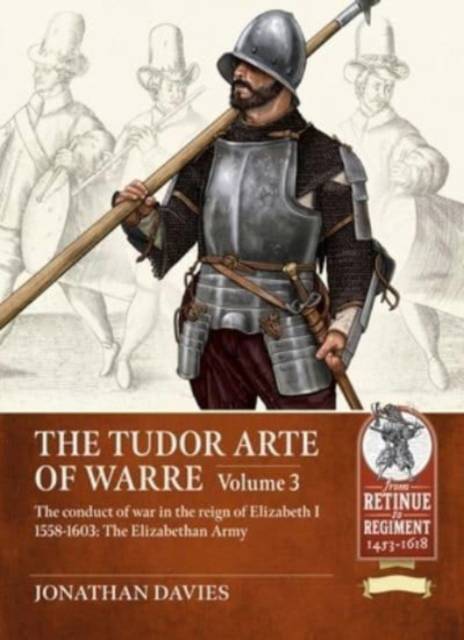
- Afhalen na 1 uur in een winkel met voorraad
- Gratis thuislevering in België vanaf € 30
- Ruim aanbod met 7 miljoen producten
- Afhalen na 1 uur in een winkel met voorraad
- Gratis thuislevering in België vanaf € 30
- Ruim aanbod met 7 miljoen producten
Zoeken
The Tudor Arte of Warre Volume 3
The Conduct of War in the Reign of Elizabeth I 1558-1603: The Elizabethan Army
Jonathan Davies
€ 48,95
+ 97 punten
Omschrijving
This volume completes the study of the Tudor Art of War and is in effect a handbook for the Elizabethan army, which explains its leadership, organization, tactics and training and recruitment. It also describes how soldiers were paid, clothed, equipped and provided for - or as was too often the case, not provided for. Wars are fought by armies; in Elizabeth's England the wars led to the creation of armies in a rather ad-hoc fashion, until the long-term commitments to Ireland and the Netherlands forced the creation of a semi-permanent institution.
An army is as good as its recruits and in Elizabeth's reign recruitment for service, either for the newly developed Trained Bands or for overseas service as pressed men, was predominantly managed by the counties. The book considers the strengths and weaknesses of the system that created a very different force from any that had gone before.
Infantry were the core of any English force, and the author provides a detailed explanation and description of the training and tactics that they were required to master if they were to face the rigors of a Continental war. The volume includes many diagrams from contemporary military handbooks which demonstrate how companies and larger formations could be deployed. It was during Elizabeth's reign that firearms came to be widely adopted, finally displacing the bow. The arquebus gave way to the caliver and the musket, as well as other 'fiery weapons'. Using contemporary sources as well as modern research, the author has evaluated the effectiveness of these weapons and how they were handled. The role of the cavalry in its various forms was a matter of much debate and the book provides a useful summary of opinions on the matter.
Elizabeth, despite being criticized for parsimony at the time, spent a vast fortune on equipping and providing for her soldiers. The counties took on much of the responsibility for recruitment and initial equipment of the soldier but on joining the army he became a royal expense. The huge sums spent on clothing, pay and provisioning gave rise to equally great opportunities for embezzlement. The state may have paid for war, but the profit went to those responsible for handling these large sums and the manufacturers and merchants who supplied them. The story is one of endemic corruption, for which the poor soldier suffered, and which consequently blunted the effectiveness of the campaigns. Military glory could not be gained by an army that was blighted from within.
Elizabethan society valued rank highly. often, it seems, above merit, and this study attempts to explain the tensions and rivalries that developed between soldiers and politicians and between men of honor. It is important to understand how all military developments were judged in relation to the classical-era ideals that dominated Renaissance thinking. The discipline and organization of the Roman Army was admired as were the virtues of the 'noble Roman'.
Elizabeth's army at the end of her reign was very different from its Tudor predecessors. It had experienced a transformation in almost every area other than in its aristocratic leadership. Whether these changes amounted to a 'military revolution' is a matter discussed in the conclusion.
The book addresses the many questions that arise when considering Elizabeth's army: an army that has long been disregarded but is well worth attention and reconsideration.
An army is as good as its recruits and in Elizabeth's reign recruitment for service, either for the newly developed Trained Bands or for overseas service as pressed men, was predominantly managed by the counties. The book considers the strengths and weaknesses of the system that created a very different force from any that had gone before.
Infantry were the core of any English force, and the author provides a detailed explanation and description of the training and tactics that they were required to master if they were to face the rigors of a Continental war. The volume includes many diagrams from contemporary military handbooks which demonstrate how companies and larger formations could be deployed. It was during Elizabeth's reign that firearms came to be widely adopted, finally displacing the bow. The arquebus gave way to the caliver and the musket, as well as other 'fiery weapons'. Using contemporary sources as well as modern research, the author has evaluated the effectiveness of these weapons and how they were handled. The role of the cavalry in its various forms was a matter of much debate and the book provides a useful summary of opinions on the matter.
Elizabeth, despite being criticized for parsimony at the time, spent a vast fortune on equipping and providing for her soldiers. The counties took on much of the responsibility for recruitment and initial equipment of the soldier but on joining the army he became a royal expense. The huge sums spent on clothing, pay and provisioning gave rise to equally great opportunities for embezzlement. The state may have paid for war, but the profit went to those responsible for handling these large sums and the manufacturers and merchants who supplied them. The story is one of endemic corruption, for which the poor soldier suffered, and which consequently blunted the effectiveness of the campaigns. Military glory could not be gained by an army that was blighted from within.
Elizabethan society valued rank highly. often, it seems, above merit, and this study attempts to explain the tensions and rivalries that developed between soldiers and politicians and between men of honor. It is important to understand how all military developments were judged in relation to the classical-era ideals that dominated Renaissance thinking. The discipline and organization of the Roman Army was admired as were the virtues of the 'noble Roman'.
Elizabeth's army at the end of her reign was very different from its Tudor predecessors. It had experienced a transformation in almost every area other than in its aristocratic leadership. Whether these changes amounted to a 'military revolution' is a matter discussed in the conclusion.
The book addresses the many questions that arise when considering Elizabeth's army: an army that has long been disregarded but is well worth attention and reconsideration.
Specificaties
Betrokkenen
- Auteur(s):
- Uitgeverij:
Inhoud
- Aantal bladzijden:
- 366
- Taal:
- Engels
- Reeks:
Eigenschappen
- Productcode (EAN):
- 9781804514092
- Verschijningsdatum:
- 30/10/2023
- Uitvoering:
- Paperback
- Formaat:
- Trade paperback (VS)
- Afmetingen:
- 178 mm x 249 mm
- Gewicht:
- 962 g

Alleen bij Standaard Boekhandel
+ 97 punten op je klantenkaart van Standaard Boekhandel
Beoordelingen
We publiceren alleen reviews die voldoen aan de voorwaarden voor reviews. Bekijk onze voorwaarden voor reviews.








